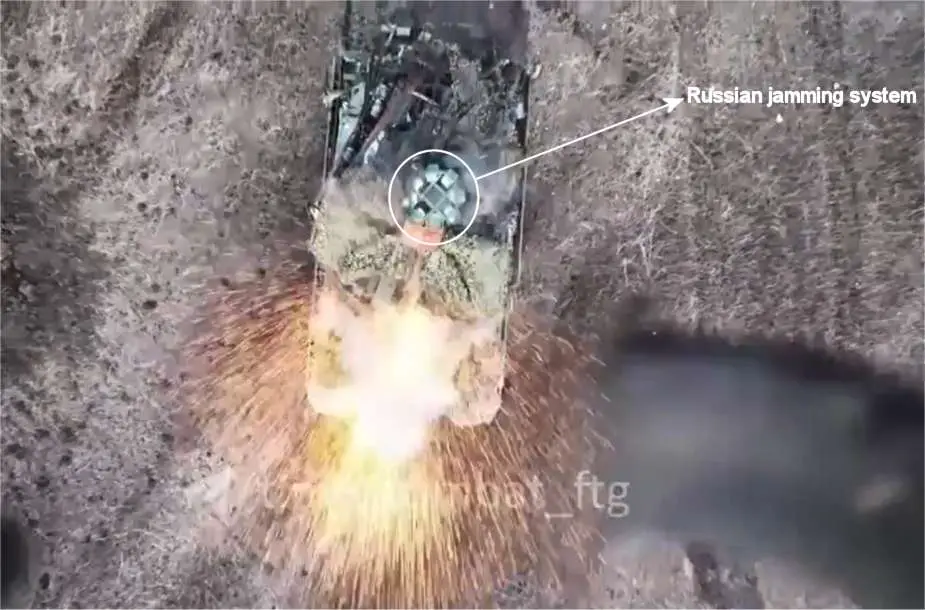- Army
- Conflicts in the world
- Israel - Iran conflict 2025
- Pakistan - India Conflict 2025
- Russia Ukraine War 2022
- Libya conflict day by day
- HAMAS - Israel War 2023
- Operation Serval in Mali French Army
- Sangaris operation Central African Republic
- Sangaris opération militaire République Centreafrique
- Ukraine - Russia conflict
- Syria conflict news
- Defence & Security Industry Technology
- Armies in the world
- Analysis Defense and Security Industry
- Conflicts in the world
- Navy
- Air
Ukraine uses drones to neutralize Russian tanks fitted with jamming system
On April 3, 2024, the Ukrainian elite unit "Shadow" successfully neutralized a Russian tank equipped with electronic warfare systems capable of countering drones. The vehicle's jamming system had reportedly been neutralized beforehand with the help of artillery, allowing the drones to come into action.
Follow Army Recognition on Google News at this link

It was only after the destruction of several Russian EW systems by artillery that it was possible to use the drones. (Picture source: Ukrainian MoD)
Soldiers from the 24th Mechanized Brigade, also known as the "Lions," reported challenges during mechanized assaults, particularly due to the Russian forces' use of drone jamming systems on their tanks. These systems are designed to jam the operation of First Person View (FPV) drones, a crucial asset in modern warfare.
A soldier from the brigade shared a vivid account of a mechanized assault near Adviivka, where Russian tanks equipped with electronic warfare capabilities jammed Ukrainian FPVs, rendering them unusable. "During one of the mechanized assaults near Adviivka, there were EW systems on the Russian tanks, which jammed absolutely all of our FPVs. It was only after the destruction of several units by artillery that it was possible to use the drones," explained the soldier.
This footage highlights the sophisticated electronic battlefield that has emerged in the conflict between Ukraine and Russia. The ability of systems to neutralize the advantage provided by Unmanned Aerial Vehicles (UAVs) underscores the need for continuous innovation in military tactics and technologies. Drones represent a significant danger on the battlefield today, and means of countering them are emerging worldwide.
The jamming systems implemented here only function properly when a certain number of them are active. The neutralization of some of the jammers allowed the drones to enter the scene, showcasing their effectiveness as we know it today. The Russians will undoubtedly continue to develop techniques to counter Ukrainian drone strikes. Even here, with a cage and jamming system, the Russian tank was destroyed with the help of drones. However, it is worth noting that the vehicle was abandoned before destruction, likely due to artillery fire and the arrival of massive drones.
The tank in question here is most likely a modified T-90M, designed and used by Russia. It is an advanced armored platform distinguished by its powerful armament and sophisticated protection. This combat vehicle weighs 46.5 tons and can reach a maximum speed of 60 km/h, providing it with good mobility on the battlefield. The main armament of the T-90M consists of a 125mm cannon, accompanied by a coaxial PKT 7.62mm machine gun and an NSVT 12.7mm machine gun.
It is equipped with standard armor reinforced by explosive reactive armor type Relikt, designed to deflect and mitigate the effectiveness of enemy projectiles. In addition to this, the T-90M has a metal mesh anti-RPG and bar armor, increasing its resilience to anti-tank attacks. The design of its protection is thus intended to offer maximum survivability on the battlefield. Furthermore, the tank here has been equipped with various modifications due to battlefield exigencies.
The tank is also equipped to operate in hostile environments thanks to its NBC protection, fire detection, and suppression system, a bulldozer blade mounted at the front, a deep fording kit, and a modern fire control system. This suite of combat equipment makes it capable of conducting operations in various conditions, from urban areas to more hostile environments. The addition of an active protection system underscores the focus on survivability and combat effectiveness of the T-90M.
With a crew of three, the T-90M measures 6.68 meters in length, 3.78 meters in width, and 2.23 meters in height, allowing it to move with agility on the battlefield while providing a stable firing platform. Its ability to travel up to 550 km without refueling extends its operational range, enabling rapid deployments and extended operations.
As the conflict continues, the emerging experiences and strategies from the frontlines in Ukraine will undoubtedly shape military doctrines and capabilities worldwide, highlighting the crucial role of electronic warfare in achieving tactical and strategic objectives.


























